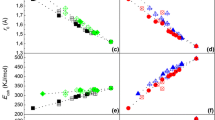Abstract
The cohesive energy of transition metals and its contributions related to the s-and d-electrons are calculated. The correlation of interatomic bonding strength, molar volume, and compressibility of transition metals with cohesion energy and corresponding contributions to it is shown. It is demonstrated that the s-electrons play an important part in the cohesion of transition metals. The main contributions to the formation energy of disordered alloys of copper with transition metals are calculated using the tight-binding approach. The results obtained are in qualitative agreement with experimental data on the thermodynamic properties of Cu-3d-metal systems.
Similar content being viewed by others
References
G. V. Samsonov, I. F. Prydko, and L. F. Pryadko, Electron Localization in Solids [in Russian], Nauka, Moscow (1976), p. 339.
M. Cyrot M and F. Cyrot-Lackmann, “Energy of formation of binary transitional alloys,” J. Phys. F: Metal Phys., 6, No. 12, 2257–2265 (1976).
D. G. Pettifor, “Theory of energy bands and related properties of 4d transition metals. III. S and d-contributions to the equation of state,” J. Phys., F8, No. 2, 219–230 (1978).
A. Pasturel, C. Colinet, and P. Hicter, “Heats of formation in transition intermetallic alloys,” Acta Metall., 32, No. 7, 1061–1067 (1984).
D. G. Pettifor, “On the tight binding theory of the heats of formation,” Sol. State Com., 28, 621–623 (1978).
W. A. Harrison, Electronic Structure and the Properties of Solids, Freeman, New York, (1980).
J. Friedel, The Physics of Metals, Cambridge University Press, New York (1969), p. 512.
Ya. P. Frenkel’, An Introduction to the Theory of Metals [in Russian], Metallurgizdat, Moscow (1972), p. 424.
A. T. Dinsdale, “SGTE data for pure elements,” CALPHAD, 15, No. 4, 317–425 (1991).
J. A. Dean (ed.), Lange’s Handbook of Chemistry, McGraw-Hill, New York (1999), p. 1291.
E. M. Sokolovskaya and L. S. Guzei, Metal Chemistry [in Russian], Izd. Mosk. Univ., Moscow (1986), p. 264.
D. G. Pettifor, “S-and d-contributions to the transition metal equation of state,” in: Proc. Int. Conf. Transit. Metals (Toronto, 1977), Bristol-London (1978), pp. 6–13.
D. G. Pettifor, “Theory of the heats of formation of transition-metal alloys,” Phys. Rev. Lett., 42, No. 13, 846–849 (1979).
A. Pasturel, P. Hicter, and F. Cyrot-Lackmann, “Heats of formation of binary transition metal alloys,” Sol. State Comm., 48, No. 6, 561–562 (1983).
M. A. Turchanin, “Enthalpy of formation of liquid alloys of cuprum and 3d-transition metals,” Metally, No. 4, 22–28 (1998).
M. A. Turchanin, “Phase equilibria and thermodynamics of binary copper systems with 3d-metals. II. The copper-vanadium system,” Powder Metall. Met. Ceram., 45, No. 5–6, 272–278 (2006).
M. A. Turchanin, “Phase equilibria and thermodynamics of binary copper systems with 3d-metals. III. Copper-chromium system,” Powder Metall. Met. Ceram., 45, No. 9–10, 457–467 (2006).
M. A. Turchanin, P. G. Agraval, and A. R. Abdulov, “Phase equilibria and thermodynamics of binary copper systems with 3d-metals. IV. Copper-manganese system,” Powder Metall. Met. Ceram., 45, No. 11–12, 569–581 (2006).
M. A. Turchanin, “Thermodynamics of liquid alloys, and stable and metastable phase equilibria in the copper-iron system,” Powder Metall. Met. Ceram., 40, No. 7–8, 337–353 (2001).
M. A. Turchanin and P. G. Agraval, “Phase equilibria and thermodynamics of binary copper systems with 3d-metals. V. Copper-cobalt system,” Powder Metall. Met. Ceram., 46, No. 1–2, 77–89 (2007).
M. A. Turchanin, P. G. Agraval, and A. R. Abdulov, “Phase equilibria and thermodynamics of binary copper systems with 3d-metals. VI. Copper-nickel system,” Powder Metall. Met. Ceram., 46, No. 9–10, 467–477 (2007).
M. A. Turchanin, “Phase equilibria and thermodynamics of binary copper systems with 3d-metals. I. The copper-scandium system,” Powder Metall. Met. Ceram., 45, No. 3–4, 143–152 (2006).
M. A. Turchanin, P. G. Agraval, A. N. Fesenko, and A. R. Abdulov, “Thermodynamics of liquid alloys and metastable phase transformations in the copper-titanium system,” Powder Metall. Met. Ceram., 44, No. 5–6, 259–270 (2005).
Author information
Authors and Affiliations
Additional information
__________
Translated from Poroshkovaya Metallurgiya, Vol. 47, No. 1–2 (459), pp. 37–54, 2008.
Rights and permissions
About this article
Cite this article
Turchanin, M.A., Agraval, P.G. Cohesive energy, properties, and formation energy of transition metal alloys. Powder Metall Met Ceram 47, 26–39 (2008). https://doi.org/10.1007/s11106-008-0006-3
Received:
Issue Date:
DOI: https://doi.org/10.1007/s11106-008-0006-3




